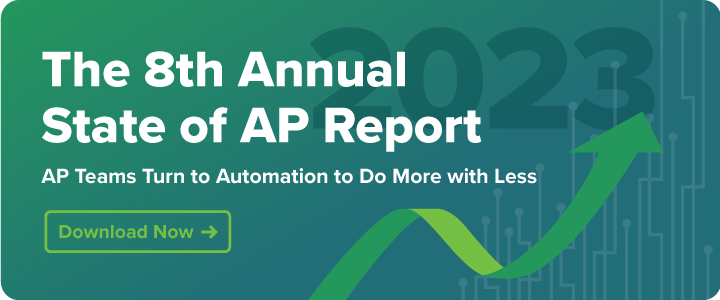What does digital transformation mean in Accounts Payable?
Digital transformation in Accounts Payable (AP) occurs when teams use technology to automate and streamline manual processes across the back office. It evaluates existing processes across the AP workflow to identify areas of improvement and help teams unlock greater efficiencies and insights.

Why is digital transformation in AP important?
Many companies today are understaffed, resulting in struggles to manage invoices and limited insights into accurate cash flow management data. These challenges have prompted more teams to prioritize AP automation as part of larger digital transformation initiatives. By improving internal processes, maximizing efficiencies, and strengthening vendor relationships, digital transformation projects help organizations optimize their limited workforces, especially in AP.
What are the benefits of AP digital transformation?
Digital transformation in AP delivers numerous benefits for businesses, including the following:
1. Increase Tracking and Visibility for Invoices
Without AP automation, it can be difficult to track invoice statuses and determine where they are in the payment process. According to a survey by iPayables, the time-wasting invoice approval process remains a top challenge for those in accounts payable. One professional in the report noted, “I hate it when invoices do not make it to AP for payment, then getting blamed when vendors get angry for nonpayment.” This challenge has only increased during the pandemic. Without people in the office to collect the mail, invoices are harder to manually track between remote and in-office workers. With fully remote and hybrid teams, companies must find solutions that enable their workforce to more effectively manage AP invoicing.
But AP automation doesn’t just increase visibility for invoices. It also provides the tools and transparency necessary for executives to unlock valuable business insights across the business. For example, advanced AP analytics gives a more accurate representation of business payments, which directly impacts overall cash flow. This reliable overview of the current financial state of the company enables CFOs and executives to make more informed decisions.
2. Simplify Capture and Coding of Invoices
It used to be that AP teams had to manually read and enter each invoice they received from vendors into their accounting system. Rather than manually entering data, teams now have the ability to automatically capture and parse data from invoices directly into their automated AP solution. Aside from efficiency gains, AP teams with automated invoice capture also boast fewer invoice capture errors than those who use manual processes.
3. Unlock More Savings
A study conducted by APQC found that there’s a wide disparity in how much money it costs businesses to process their invoices. For example, some businesses spend an average of $12.44 per invoice, while others spend an average of $4.98. Why the difference? APQC reports that industries using manual accounts payable invoice processing typically pay more in labor expenses. Aside from increased accuracy and intelligence, automation for AP teams also helps reduce operating and payment processing expenses.
4. Ability to Sustain and Scale Teams
Many organizations today face herculean staffing issues. In fact, a recent survey by Willis Towers Watson reveals that as many as 44% of employees are looking for a new job.
These high turnover rates particularly hinder lean AP departments, since these positions may not be replaced as quickly as other essential functions. For example: A hospital may prioritize hiring nurses and doctors over their back-end business operations. Luckily, digital transformation in AP can help finance teams do more with less: 61% of teams who have implemented AP automation are processing more invoices with the same size team.
5. Improve Supplier Relationships
It’s no secret that suppliers like to get paid on time and that fast payments improve vendor relationships. As supply chains remain volatile and unpredictable, it’s more important than ever for companies to prioritize their supplier relationships in order to ensure the delivery of necessary goods and services.
Suppliers are also becoming more strategic for companies looking to compete in today’s economy. According to 71% of those surveyed, their vendor relationships grew more important over the last year. This number is even higher for those in healthcare, clocking in at 75%. AP automation strengthens supplier relationships by making it easier for AP teams to pay their vendors on time. Systems like MineralTree TotalAP can easily sort payments by their due date so teams can quickly schedule payments to arrive before their deadline and ensure they stay on their vendor’s good side.
6. Support Business Growth
Oftentime, businesses experiencing aggressive growth do not have the internal resources to immediately process vast increases in their monthly invoice volume. BrightView Health experienced this problem, as they expanded from four treatment centers to over 30 in just two years. Through their manual process, BrightView was able to pay 3,000 invoices. However, the number of invoice payments increased to over 10,000, resulting in challenges for the business. With MineralTree AP Automation, BrightView was able to reduce its invoice processing time and gain more insights into the payment process.
AP automation helps mid-size and enterprise businesses manage acquisitions with its ability to sync data across multiple ERP systems. Manual systems make this process a major headache for AP teams, since they must simultaneously route and track different types of invoices (digital and paper-based) for multiple locations or entities. Luckily, AP automation simplifies this process by digitizing and centralizing all documents into a single platform to support further business growth.
7. Empower New Workforce Models
The pandemic has likely forever changed how businesses operate. Companies that were previously in-person were forced to go remote, creating a boom of hybrid and remote workers. Even now almost three years later, most offices have not resumed a fully in-person working model as was once expected. Instead many teams remain hybrid or fully remote.
Teams still utilizing manual AP processes tend to struggle with approving invoices and facilitating payments. Additionally, if companies have more than one location or are receiving invoices via mail, it’s more difficult for the AP team to track and manage the invoice for payment. Digital transformation mitigates these challenges by digitizing these processes, making the entire end-to-end accounts payable process easier, less expensive, and more efficient.
8. Reduce Risk of Fraud
71% of financial professionals reported that their organization has experienced either a payment fraud attack or attempt. AP automation reduces the risk of a successful fraud attack by automatically cross referencing invoice information against all records found in your company’s ERP. If the data does not match, AP automation tools will alert the team of the possible invoice fraud and flag it for review.
AP automation also offers similar safeguards to alert your team whenever there are changes made to a vendor’s payment information. Ensuring that both you and the vendor know when changes are made to their file, makes it quick and easy to identify any fraud attempts.
9. Save Money by Reducing Manual Tasks
The AP workflow is full of expensive and time-consuming manual tasks: answering vendor inquiries, routing invoice approvals, and executing payments. Aside from requiring additional headcount and resources, these manual tasks have a higher risk of human error, which can lead to duplicate payments and increased fraud risk. Alternatively, AP automation automates these tedious tasks and unlocks new efficiency gains, saving your team time and money. In turn, they can focus on more value-add, strategic projects.
10. Pay Vendors in Their Preferred Payment Format
Additional processes are often required when setting up a new payment format, which can cause additional stress for an already-overworked AP team. However, AP automation tools make it easier to pay vendors in their preferred format without adding any additional steps for your team. Accounts payable teams can facilitate various electronic payment methods and checks via one system.
11. Cash In On Rebates
Companies that embrace virtual cards can cash in on rebates, earning additional money for the business. For example, Quartzy, a life science company, leverages SilverPay to earn rebates on the invoices paid. As a result, they’re on track to earn $100,000, which covers more than they invested in their AP automation solution.
Final Thoughts
As organizations embark on digitizing their financial function, it’s important to tackle various departments in segments. Automating AP is a strategic first step for finance teams, providing companies with numerous benefits including insight into cash flow, reduced expenses, and improved operational efficiency. For this reason, AP automation is the #1 back-office digitization priority for the last two years.
An AP automation and digital transformation tool like MineralTree makes it easy to pay vendors in their preferred format, gain visibility into the invoice and payment process, and eliminate manual tasks. To learn more about how MineralTree can help finance teams and CFOs prepare for digital transformation through AP automation, request a demo today.



